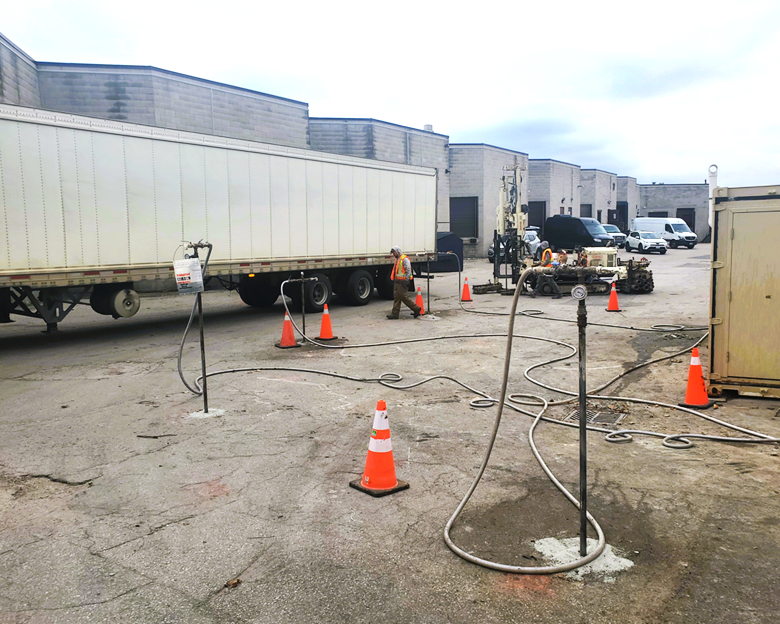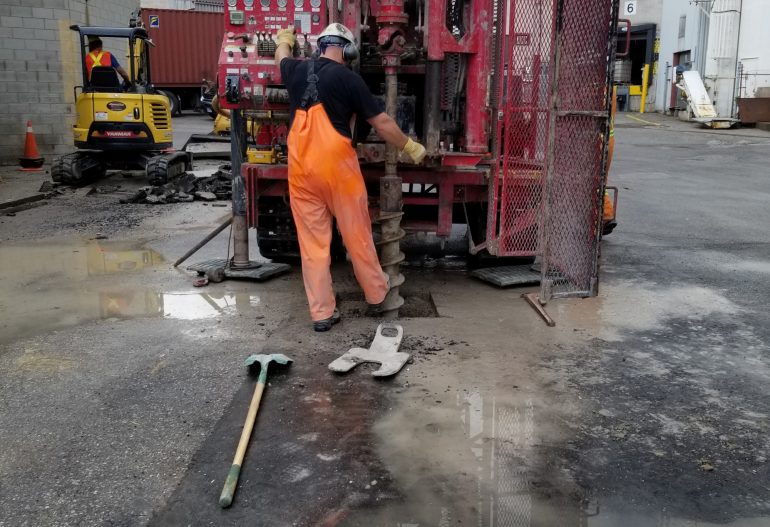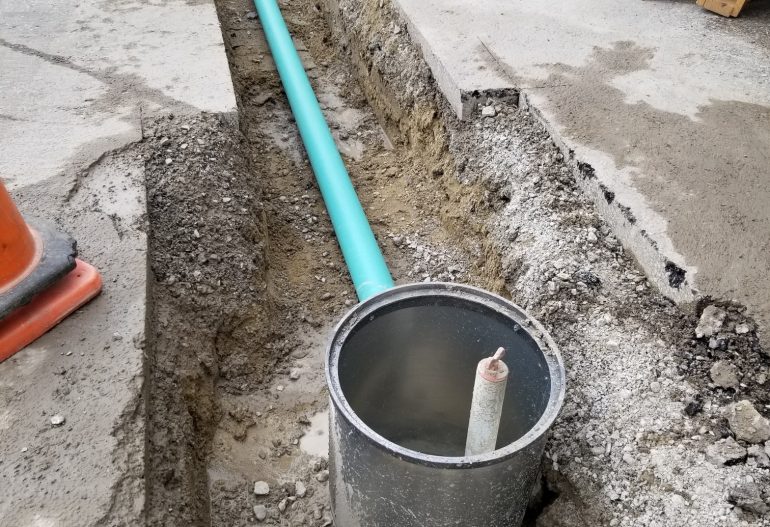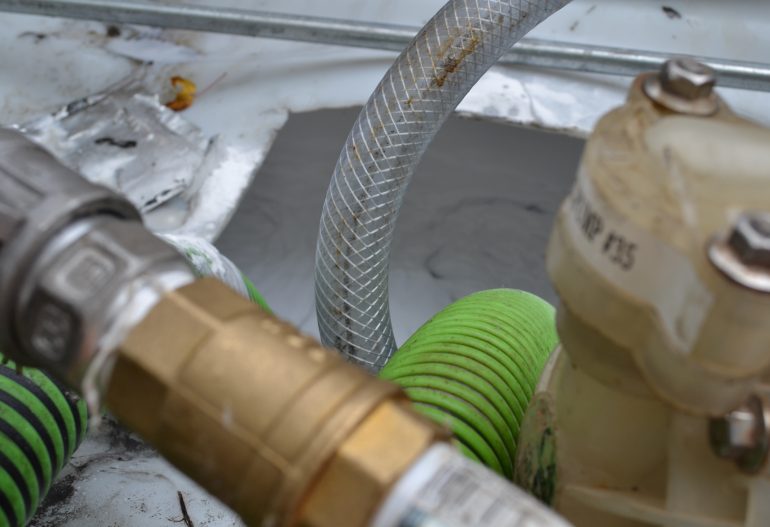In-Situ Chlorinated Solvent Remediation Enabling an Industrial Property Sale


A large multi-tenant property in active use by industrial, commercial, and institutional tenants was facing a major hurdle prior to its sale. Following the recommendations of a Phase One Environmental Site Assessment (ESA), AEL conducted a Phase Two (ESA) on the site, which confirmed the site had been heavily contaminated by chlorinated solvents.
Laboratory testing confirmed the presence of the following Contaminants of Concern (CoCs) in soil, groundwater, sub-slab vapour, and indoor air at concentrations well above safe health limits:
Trichloroethylene (TCE)
- A common industrial degreasing solvent
TCE Degredation Products
- cis-1,2-Dichloroethylene (cis-1,2-DCE)
- trans-1,2-Dichloroethylene (trans-1,2-DCE)
- Vinyl chloride (VC) – a highly carcinogenic compound
Real-World Impact of TCE Contamination
The contamination source sat beneath and beside one of the property’s buildings, and the plume stretched under another building, toward a residential area.
Concentrations of chlorinated solvents in the site’s groundwater near the source of the contamination were in the range of 10-50 parts per million (PPM), in some areas likely present as pure liquid. Vapour intrusion resulted in indoor air contamination more than 100 times over what is considered safe according to Ontario’s Health Based Indoor Air Criteria (HBIAC).
Without corrective measures, the chlorinated solvents would persist long-term and would continue off-gassing into the buildings, impacting indoor air quality, and potentially migrating off-site, diminishing the property’s value and a potentially exposing its owners to legal liability.

A Highly Tactical RAP
AEL designed a strategic Remedial Action Plan (RAP) with the following goals:
- Safeguard human health by addressing immediate, unacceptable risks from vapour intrusion into occupied buildings and the potential for off-site contaminant migration toward a nearby residential area.
- Protect business continuity by completing remediation without disrupting daily operations including deliveries at busy loading docks.
- Enable property sale by mitigating risks from contamination.
STAGE ONE – Protect Occupants Using Soil Vapour Extraction (SVE)
Since indoor air contamination presented the highest risk to overcome for sale and occupation of the site, AEL first reduced on site vapour intrusion to the buildings by installing a soil vapour extraction system (SVE system) directly within the source area.
- Four reinforced wells were carefully trenched into the ground around a busy loading dock, engineered to withstand heavy truck traffic, and connected to a vacuum blower and treatment system
- Tenants were able to continue business as usual, while vapour risks were brought under control
- Within two years, the system captured and treated over 50 kg of solvents
STAGE TWO – Destroy the Source with Enhanced Reductive Dechlorination (ERD)
With the immediate risks managed, AEL targeted the contamination itself. A full-scale ERD program was selected as the most efficient remediation technology.
- ERD has several advantages over other common soil and groundwater remediation technologies, including cost, longevity of sustained treatment, and limited site disturbance
- ERD is often performed by injection of remedial amendments into groundwater, which triggers multiple pathways of reductive dechlorination, which destroys chlorinated solvent molecules
- For this project, ERD was carried out by injecting emulsified vegetable oil (EVO) with zero valent iron (ZVI) and dechlorinating bacteria
- The ERD program was designed as a hybrid approach to treat the source of contamination and to form a Permeable Reactive Barrier (PRB) surrounding the treatment area. The material allows groundwater to pass through while removing and/or destroying contaminants within it.
- Due to the location of the ERD work (within an active loading dock area), AEL provided a schedule for injections that accommodated the delivery schedules for multiple tenants, allowing continuity of tenant business operations while remedial work took place
Outcome: Contaminant Reduction, Zero Vapour Intrusion, Successful Sale
By controlling immediate risks, removing the source of contamination, and keeping tenants operational throughout the project, AEL turned a major liability into a marketable asset. The combined SVE and ERD remedial approach achieved:
- 94–100% reduction in solvent concentrations at the source
- Elimination of vapour intrusion into buildings, protecting tenants and meeting Ontario’s health-based indoor air criteria
- Mitigation of off-site migration risk, protecting neighbouring properties

AEL environment creates tailored solutions for each property based on its clients’ goals.
Let’s talk, and our team will guide you through the process.
Want to Learn More About AEL’s Remediation Techniques?
25 Years of Innovation in Environmental Site Remediation
Dig deeper into some of the most important innovations in the field of environmental remediation.
Case Study: Ex-Situ Bioremediation of a Hydrocarbon Contaminated Site
Watch our insightful webinar showcasing one of AEL’s soil remediation projects using innovative ex-situ bioremediation of a hydrocarbon contaminated site.
What Our Customers Have To Say
In my two decades plus as a specialist in Environmental Law, I have dealt with numerous environmental consulting firms right across Canada, and from big to small, Not all of them are able to deal with sophisticated scientific questions and not all of the ones with greater scientific skills are practical. AEL Environment have the necessary science skills and their advice is always practical. They have never failed to help me and my clients.
Michael Peterson, Environmental Law
Sky Counsel Group
